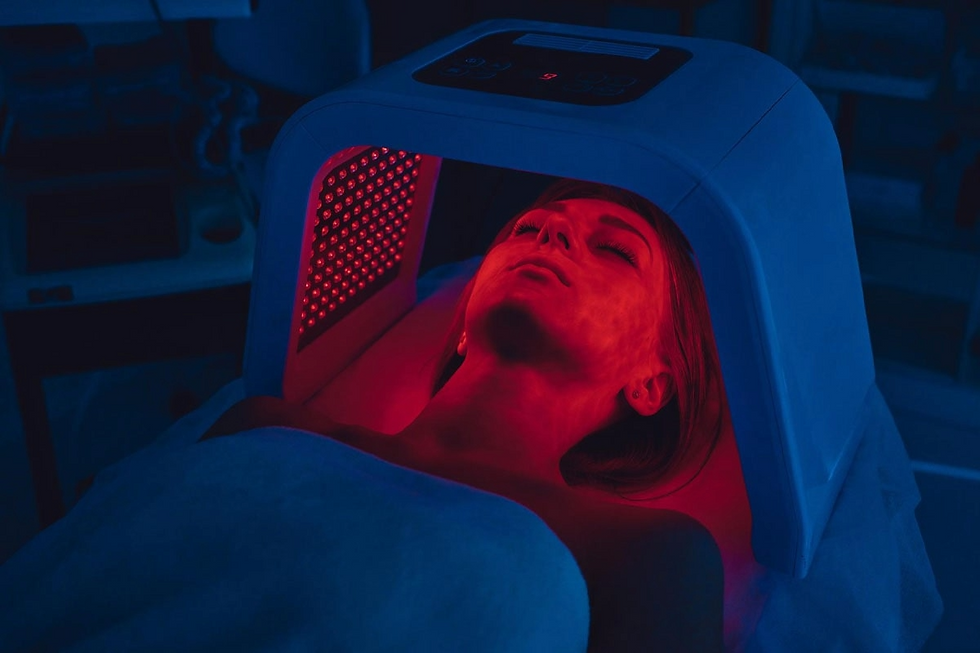Research Shows Red & Near Infrared Light Therapy Improves Hashimoto’s
- Matrix Massage & Bodywork
- Jul 7
- 3 min read
Red Light Therapy for Hashimoto’s: What European Research Says
If you’re living with Hashimoto’s thyroiditis, you already know it’s an autoimmune condition that can cause your thyroid to underperform over time — and conventional treatments focus mostly on hormone replacement. But did you know that low-level laser therapy (LLLT) — also called red light therapy — has actually been studied in Europe and Brazil as a supportive option for Hashimoto’s?
Here’s what the science says so far.
🔬What Is Low-Level Laser Therapy (LLLT)?
LLLT, or photobiomodulation, uses safe, low-power wavelengths of red and near-infrared light to help cells produce energy, reduce inflammation, and promote tissue repair. It’s been widely studied for skin healing, joint pain, and hair regrowth — but thyroid researchers have been exploring its effects on autoimmune thyroid conditions, too.
📚Key Human Studies
✅ 1️⃣ 2013 Brazilian Randomized Controlled Trial
In 2013, Höfling et al. published a study on 43 patients with chronic autoimmune thyroiditis (Hashimoto’s disease). One group received low-level laser therapy directly over their thyroid glands twice a week for 10 sessions, while the other group got a placebo light.
Results:
47% of patients who got real red light therapy were able to reduce or even stop their thyroid hormone medication for up to 9 months.
TPO antibodies dropped by an average of 35%.
Ultrasounds showed better blood flow and healthier-looking thyroid tissue.
✅ 2️⃣ Long-Term Follow-Up
A follow-up by the same research team in 2018 found that patients who did periodic maintenance sessions were able to preserve some of these benefits for up to 6 years.
🧬How Might Red Light Help Hashimoto’s?
Research suggests red and near-infrared light:
Increases local blood flow to the thyroid
Supports cellular energy (ATP) production in thyroid cells
May gently shift local immune activity to reduce excess inflammation
Could help keep thyroid tissue healthy and functioning longer
✅How They Do It in Europe
In many European and Russian clinics, practitioners use small medical-grade lasers or LED devices at 660–830 nm wavelengths — the same range you’ll find in many high-quality wellness panels (like the one at Matrix Massage & Bodywork) Typical sessions involve short exposures (2–5 minutes per thyroid lobe) a few times a week for several weeks.
🔦Can You Try This Yourself?
In the research, red light therapy was done under medical supervision, but many people now use high-quality LED panels with similar wavelengths at home for general wellness.
Important: If you choose to explore red light therapy for thyroid support:
Always talk to your healthcare provider first
Monitor your thyroid labs regularly (TSH, Free T4, Free T3, TPO antibodies)
Keep sessions short and gentle — more isn’t always better
Don’t stop prescribed medication without medical guidance
✅Key Takeaway
The science is clear: Red light therapy for Hashimoto’s is not just a wellness trend — it’s been studied with real people, real results, and real follow-ups in other parts of the world. While more large-scale studies would be great, these early findings are exciting for anyone looking to support thyroid health naturally.
⚠️Safe Use Disclaimer
This article is for educational purposes only. It does not replace medical advice, diagnosis, or treatment. Always consult your healthcare provider before starting any new wellness therapy, changing your medications, or adding devices like red light panels to your self-care routine.
✅References
Höfling DB, Chavantes MC, Juliano Y, et al. Low-level laser in the treatment of patients with hypothyroidism induced by chronic autoimmune thyroiditis: a randomized controlled clinical trial. Lasers Surg Med. 2013;45(7):487–493. PubMed
Höfling DB, Chavantes MC. Effects of low-level laser therapy on autoimmune hypothyroidism over six years. Photomed Laser Surg. 2018;36(7):363–366. PubMed



Comments